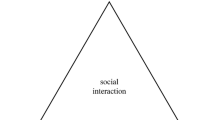Abstract
This article presents a dynamic method of supporting new faculty through a peer support group led by a facilitator. Group members participate in ongoing self-assessment, individualized goal setting, and activities that reflect the changing needs of the group. We explain the history and activities of the group and also the benefits for institutions considering developing a support mechanism for new faculty.
Similar content being viewed by others
References
Alexander, J. C. (1992). Mentoring: On the road to tenure and promotion. Association for Communication Administration Bulletin, 79, 54–58.
Belenky, M. F., Clinchy, B. M., Goldberger, N. R., & Tarule, J. M. (1986). Women's ways of knowing: The development of self, voice, and mind. New York: Basic Books.
Bergen, D., & Connelly, J. (1988). The collegial research mentor project: A model for faculty research and scholarship development. Career Planning and Adult Development Journal, 4, 3–8.
Boyle, P., & Boice, B. (1998). Systematic mentoring for new faculty teachers and graduate teaching assistants. Innovative Higher Education, 22, 157–179.
Chalmers, R. K. (1992). Faculty development: The nature and benefits of Mentoring. Journal of Pharmaceutical Education, 56, 71–74.
Gaskill, L. R. (1993). A conceptual framework for the development, implementation, and evaluation of formal mentoring programs. Journal of Career Development, 20, 147–160.
Goodwin, L. D., Stevens, E. A., & Bellamy, G. T. (1998). Mentoring among faculty in schools, colleges, and departments of education. Journal of Teacher Education, 49, 334–343.
Harnish, D., & Wild, L. A. (1994). Mentoring strategies for faculty development. Studies in Higher Education, 19, 191–201.
Henry, J. (1994). A formal mentoring program for junior female faculty. Initiatives, 56(2), 37–45.
Johnsrud, L. K., & Atwater, C. D. (1993). Scaffolding the ivory tower: Building supports for faculty new to the academy. CUPA Journal, 44, 1–14.
Kirk, J. J. (1992). Establishing a faculty mentoring program. Association for Communication Administration Bulletin, 79, 59–65.
Kram, K. E. (1985). Improving the mentoring process. Training and Development Journal, 39, 40–43.
Lowe, A. A., Boyd, M. A., & Brunette, D. M. (1991). Mentoring and pretenure faculty development. Journal of Dental Education, 55, 665–678.
McPherson, M. S., & Schapiro, M. O. (1999). Tenure issues in higher education. Journal of Economic Perspectives, 13, 84–97.
Mullaney, J. W., & Timberlake, E. M. (1994). University tenure and the legal system: Procedures, conflicts, and resolutions. Journal of Social Work Education, 30, 172–184.
Nye, G. T., & Maxcy, S. J. (1994, October). Mentoring to build diversity in the university community. Paper presented at the Convention of the University Council for Educational Administration, Philadelphia, PA.
Olian, J. D., Carroll, S. J., Giannantonio, C. M., & Feren, D. B. (1988). What do proteg´es look for in a mentor? Results of three experimental studies. Journal of Vocational Behavior, 33, 15–37.
Pierce, G. (1998). Developing new university faculty through mentoring. Journal of Humanistic Education and Development, 37, 27–38.
Ragins, B. R., & Cotton, J. L. (1999). Mentor functions and outcomes: A comparison of men and women in formal and informal mentoring relationships. Journal of Applied Psychology, 84, 529–550.
Ragins, B. R., & Cotton, J. L. (1991). Easier said than done: Gender differences in perceived barriers to gaining a mentor. Academy of Management Journal, 34, 939–951.
Sorcinelli, M. D. (1994). Effective approaches to new faculty development. Journal of Counseling and Development, 72, 474–479.
St. Clair, K. L. (1994). Faculty-to-faculty mentoring in the community college: An instructional component of faculty development. Community College Review, 22(3), 23–35.
Wunsch, M. (1994). Giving structure to experience: Mentoring strategies for women faculty. Initiatives, 56(1), 1–10.
Author information
Authors and Affiliations
Rights and permissions
About this article
Cite this article
Smith, J.O., Whitman, J.S., Grant, P.A. et al. Peer Networking as a Dynamic Approach to Supporting New Faculty. Innovative Higher Education 25, 197–207 (2001). https://doi.org/10.1023/A:1007651632485
Issue Date:
DOI: https://doi.org/10.1023/A:1007651632485




